2014 BMW i3 Review
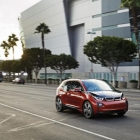
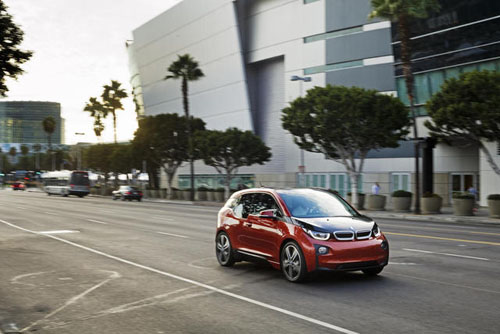 The BMW i3 is the first of two production cars developed by BMW’s Project i team. Past works from the team were lease-only pilots of ‘conversion’ electric-vehicles based on current BMW and MINI models. Taking a gas powered car and modifying it into an electric one will always result in some compromises, much like trying to substitute flour in a baking recipe for anything gluten-free. As such, the BMW i3 is gluten-free; err gas-free, from the get-go. Since BMW imagines that tree-huggers like boasting about their tiny carbon footprint, the i3 features an eco-friendly approach and a focus on lightweight materials.
The BMW i3 is the first of two production cars developed by BMW’s Project i team. Past works from the team were lease-only pilots of ‘conversion’ electric-vehicles based on current BMW and MINI models. Taking a gas powered car and modifying it into an electric one will always result in some compromises, much like trying to substitute flour in a baking recipe for anything gluten-free. As such, the BMW i3 is gluten-free; err gas-free, from the get-go. Since BMW imagines that tree-huggers like boasting about their tiny carbon footprint, the i3 features an eco-friendly approach and a focus on lightweight materials.
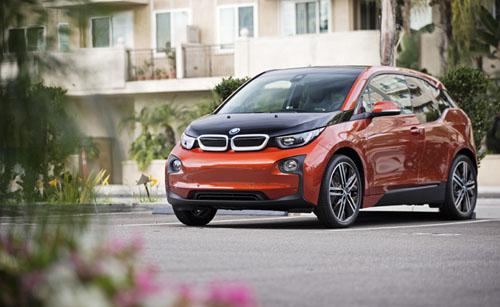 At under 2,700 lbs. the i3 uses a copious amount of carbon fiber – a strong lightweight material usually reserved for high-performance and pricey sports-cars. In fact, the i3 features the first mass produced carbon-fiber passenger compartment. Due to the low weight of the vehicle, BMW uses a small battery and electric motor, which are mounted low and rearward, by the drive-wheels. This layout allows optimum cabin space – there’s no transmission tunnel or mass of batteries invading the passenger compartment. With the weight over the drive wheels, the car should also deliver solid traction and performance. The one-two combo of battery and motor deliver an acceptable 170 hp and hard-hitting 184 lb-ft of torque.
At under 2,700 lbs. the i3 uses a copious amount of carbon fiber – a strong lightweight material usually reserved for high-performance and pricey sports-cars. In fact, the i3 features the first mass produced carbon-fiber passenger compartment. Due to the low weight of the vehicle, BMW uses a small battery and electric motor, which are mounted low and rearward, by the drive-wheels. This layout allows optimum cabin space – there’s no transmission tunnel or mass of batteries invading the passenger compartment. With the weight over the drive wheels, the car should also deliver solid traction and performance. The one-two combo of battery and motor deliver an acceptable 170 hp and hard-hitting 184 lb-ft of torque.
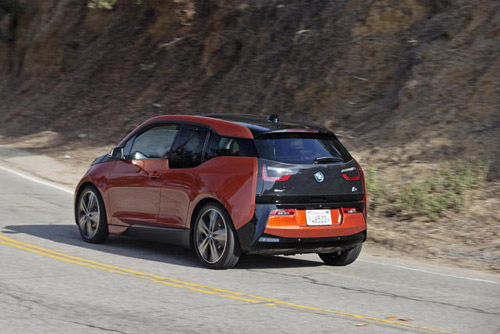 The peppy i3 will drive an estimated 80-100 miles before needing a recharge. By using the i3’s Eco and Eco Pro drive modes (and maybe uttering a quick prayer to Elon Musk) the driver can eke out 24 percent better range at the expense of responsiveness and constant air-conditioning. Recharge time is under 4 hours using a 240-volt charger and just 30 minutes using the optional DC combo fast charging system. Without a doubt, that 80-100 mile range isn’t as jaw dropping as the rest of the car’s stat-sheet – so the i3 is available with a 650 cc two-cylinder engine borrowed from the brand’s motorcycle division.
The peppy i3 will drive an estimated 80-100 miles before needing a recharge. By using the i3’s Eco and Eco Pro drive modes (and maybe uttering a quick prayer to Elon Musk) the driver can eke out 24 percent better range at the expense of responsiveness and constant air-conditioning. Recharge time is under 4 hours using a 240-volt charger and just 30 minutes using the optional DC combo fast charging system. Without a doubt, that 80-100 mile range isn’t as jaw dropping as the rest of the car’s stat-sheet – so the i3 is available with a 650 cc two-cylinder engine borrowed from the brand’s motorcycle division.
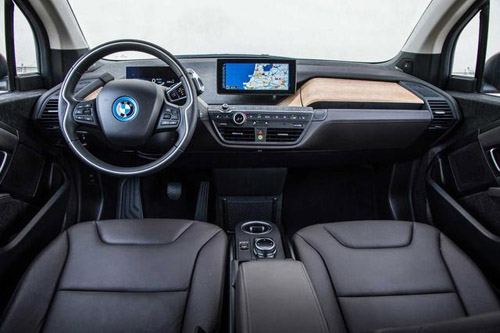 When the electric range reaches a certain point, the gas engine turns on, but doesn’t turn the drive wheels; instead it maintains the battery’s charge and nearly doubles the car’s original range to about 180 miles. We didn’t get a chance to test it, but the range-extender may dull the enjoyment behind the wheel as it adds 330 lbs and presumably alters the near 50/50 weight distribution. BMW knows that buyers of hybrids and electric vehicles like a sense of differentiation, but is the i3 a bit too kooky looking? Its upright look reminds us a bit of the Honda Fit and the rear suicide doors are a unique flare with their larger window opening than the front doors. BMW’s usual signatures are present; including the dual-kidney shaped grilles, the LED corona headlights and the sleek looking LED tail lights.
When the electric range reaches a certain point, the gas engine turns on, but doesn’t turn the drive wheels; instead it maintains the battery’s charge and nearly doubles the car’s original range to about 180 miles. We didn’t get a chance to test it, but the range-extender may dull the enjoyment behind the wheel as it adds 330 lbs and presumably alters the near 50/50 weight distribution. BMW knows that buyers of hybrids and electric vehicles like a sense of differentiation, but is the i3 a bit too kooky looking? Its upright look reminds us a bit of the Honda Fit and the rear suicide doors are a unique flare with their larger window opening than the front doors. BMW’s usual signatures are present; including the dual-kidney shaped grilles, the LED corona headlights and the sleek looking LED tail lights.
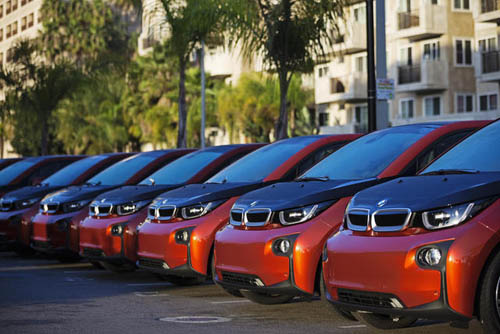 It’s hard to call the i3 sexy, but it certainly is noticeable – in a friendly alien sort of way. Step inside the i3 and it’s a similarly polarizing design. The only element recognizable from the rest of the BMW family is the iDrive screen and controller. The gear shifter and start/stop button is actually a steering column mounted knob. A decidedly less-cool location for a shifter, the interior does gain a bit of space by moving it up and away from the center console. The aura of the interior is decidedly high-tech, even feeling a bit like a concept vehicle due to the clean and uncluttered look. However, it doesn’t exactly feel like a premium product. While some parts are interesting to look at, like the eucalyptus wood dash, they feel odd to the touch.
It’s hard to call the i3 sexy, but it certainly is noticeable – in a friendly alien sort of way. Step inside the i3 and it’s a similarly polarizing design. The only element recognizable from the rest of the BMW family is the iDrive screen and controller. The gear shifter and start/stop button is actually a steering column mounted knob. A decidedly less-cool location for a shifter, the interior does gain a bit of space by moving it up and away from the center console. The aura of the interior is decidedly high-tech, even feeling a bit like a concept vehicle due to the clean and uncluttered look. However, it doesn’t exactly feel like a premium product. While some parts are interesting to look at, like the eucalyptus wood dash, they feel odd to the touch.
This is a result of sustainable, eco-minded approach to the i3. Materials in the car made from renewable resources include that eucalyptus dash, Kenaf plant fiber panels and leather seats that are naturally tanned using olive-leaf extract. The overall look is nice, but the materials feel coarser than other BMW interiors.In terms of interior capacity, BMW says the car is as spacious as its 3 Series sports-sedan – an impressive feat considering the i3 is shorter than even the 1 Series. BMW hasn’t released any interior dimensions on the car, however, and a real world test proves the rear seat to be rather tight on legroom. Up front it’s plenty spacious though, and feels it thanks to generous headroom afforded by the vehicle’s oddball shape. -Autoguide


